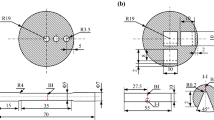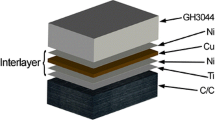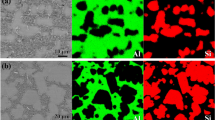Abstract
The carbon reinforced silicon carbide ceramic matrix composites (C/SiC) were brazed to Fe-Ni-Co superalloy (GH783) with Cu-Ti + Mo solder under vacuum at 1000 °C. The influence of thermal shock (in air at 800 °C) and environment temperature on mechanical properties of the joint were investigated. The joint between C/SiC composites and GH783 was dense, crack free, and was comprised of reaction layer, stress relief layer, plastoelastic layer, and diffusion layer. Thermal shock damage and oxidative damage were both existing after the thermal shock. Therefore, the flexural strength of the joint decreased dramatically with the increase of thermal shock times. After 5, 10, and 15 times of thermal shock, the flexural strength of the joint decreased to 42.9, 22.7, and 9.7% of the initial strength, respectively. The flexural strength of the joint decreased dramatically with the increase of environment temperature because of the thermal mismatch between C/SiC and the interface reaction layer. The flexural strength of the joint at 600, 800, and 900 °C was decreased to 60, 39, and 29% of that at room temperature, respectively.

The C/SiC was brazed to GH783 with Cu-Ti + Mo solder under vacuum at 1000 °C. The joint between C/SiC and GH783 was dense and crack free. The flexural strength of the joint decreased dramatically with the increase of thermal shock times. The reaction layer had been completely oxidized which was analyzed by EDS and SEM. The flexural strength of the joint decreased dramatically with the increase of environment temperature. The fracture surface morphology was examined by SEM.









Similar content being viewed by others
References
Naslain RR (2005) SiC-matrix composites: nonbrittle ceramics for thermo-structural application. Int J Appl Ceram Technol 2(2):75–84
Christin F (2010) Design, fabrication, and application of thermostructural composites (TSC) like C/C, C/SiC, and SiC/SiC Composites. Adv Eng Mater 4(12):903–912
Schmidt S, Beyer S, Knabe H et al (2004) Advanced ceramic matrix composite materials for current and future propulsion technology applications. Acta Astronaut 55(3–9):409–420
Liu Y, Zhang L, Cheng L et al (2009) Preparation and oxidation protection of CVD SiC/a-BC/SiC coatings for 3D C/SiC composites. Corrosion Science 51(4):820–826
Krenkel W, Berndt F (2005) C/C–SiC composites for space applications and advanced friction systems. Mater Sci Eng A 412(1–2):177–181
Krenkel W, Naslain R, Schneider, H (2006) High Temperature Ceramic Matrix Composites. Wiley-VCH, Munich
Fan S, Zhang L, Xu Y et al (2007) Microstructure and properties of 3D needle-punched carbon/silicon carbide brake materials. Compos Sci Technol 67(11–12):2390–2398
Krenkel W (2003) C/C-SiC composites for hot structures and advanced friction systems. Cocoa Beach Conference & Exposition, Forida, 26-31 January. Vol. 24, pp 583–592. DLR
Fan S, Zhang L, Xu Y et al (2008) Microstructure and tribological properties of advanced carbon/silicon carbide aircraft brake materials. Compos Sci Technol 68(14):3002–3009
Hu W, Wang L, Wu Q et al (2014) Preparation, characterization and microwave absorption properties of bamboo-like β-SiC nanowhiskers by molten-salt synthesis. J Mater Sci Mater Electron 25(12):5302–5308
Xiong J, Li J, Zhang F et al (2006) Joining of 3D C/SiC composites to niobium alloy. Scripta Mater 55(2):151–154
Chang L, Shu W, Chen S et al (2011) Preparation of graphene oxide–molecularly imprinted polymer composites via atom transfer radical polymerization. J Mater Sci 46(7):2024–2029
Liu Y, Huang ZR, Liu XJ (2009) Joining of sintered silicon carbide using ternary Ag–Cu–Ti active brazing alloy. Ceram Int 35(8):3479–3484
Nie J, Xu Y, Zhang L et al (2010) Microstructure, thermophysical, and ablative performances of a 3D needled C/C–SiC composite. Int J Appl Ceram Technol 7(2):197–206
Jian K, Chen ZH, Ma QS et al (2005) Processing and properties of 2D-C f /SiC composites incorporating SiC fillers. Mater Sci Eng A 408(1–2):330–335
Han GW, Zhang YY (2006) Variations in microstructure and properties of GH783 alloy after long term thermal exposure. Mater Sci Eng A 441(1):253–258
Wang X, Cheng L, Fan S et al (2012) Microstructure and mechanical properties of the GH783/2.5D C/SiC joints brazed with Cu–Ti + Mo composite filler. Mater Des 36:499–504
Ma J, Xu Y, Zhang L et al (2006) Microstructure characterization and tensile behavior of 2.5D C/SiC composites fabricated by chemical vapor infiltration. Scripta Mater 54(11):1967–1971
Wu H, Wu G, Wang L (2015) Peculiar porous α-Fe2O3, γ-Fe2O3, and Fe3O4, nanospheres: facile synthesis and electromagnetic properties. Powder Technol 269:443–451
Wu H, Wu G, Ren Y et al (2015) Co2+/Co3+ Ratio dependence of electromagnetic wave absorption in Hierarchical NiCo2O4-CoNiO2 Hybrids. J Mater Chem C 3(29):7677–7690
Wu G, Cheng Y, Ren Y et al (2015) Synthesis and characterization of γ-Fe2O3@C nanorod-carbon sphere composite and its application as microwave absorbing material. J Alloys Compd 652:346–350
Lin GB, Huang JH (2006) Brazed joints of C–SiC composite to Ti alloy using Ag–Cu–Ti–(Ti + C) mixed powder as interlayer. Powder Metall 49(4):345–348
Yang Z W, Zhang L X, He P et al (2012) Interfacial structure and fracture behavior of TiB whisker-reinforced C/SiC composite and TiAl joints brazed with Ti–Ni–B brazing alloy. Mater Sci Eng A 532(1):471–475
Yang Z, Zhang LX, Tian X et al (2013) Interfacial microstructure and mechanical properties of TiAl and C/SiC joint brazed with TiH 2 –Ni–B brazing powder. Mater Charact 79:52–59
Cui B, Huang J, Cai C et al (2014) Microstructures and mechanical properties of C f /SiC composite and TC4 alloy joints brazed with (Ti–Zr–Cu–Ni)+W composite filler materials. Compos Sci Technol 97(97):19–26
Acknowledgements
The authors would like to acknowledge the financial support of the Natural Science Foundation of China (51672218), Shaanxi science and technology research and development projects (2014K08-20), Creative Research Foundation of Science and Technology on Thermostructural Composite Materials Laboratory (6142911020106), the Research Fund of the State Key Laboratory of Solidification Processing (NWPU, SKLSP201645), China (Grant No. 145-QZ-2016), and the special fund for basic scientific research of central colleges of Chang’an University (No. 0012-310600161000).
Author information
Authors and Affiliations
Corresponding author
Rights and permissions
About this article
Cite this article
Deng, J., Zheng, B., Fan, S. et al. Influence of thermal shock and environment temperature on mechanical properties of C/SiC/GH783 joint brazed with Cu-Ti + Mo. Adv Compos Hybrid Mater 1, 199–205 (2018). https://doi.org/10.1007/s42114-017-0010-5
Received:
Revised:
Accepted:
Published:
Issue Date:
DOI: https://doi.org/10.1007/s42114-017-0010-5




